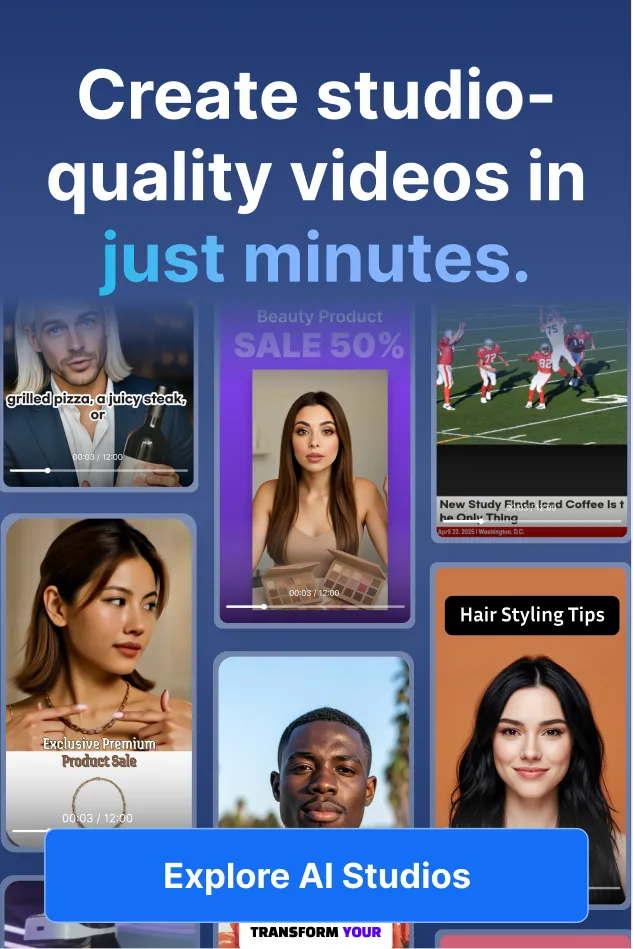Khởi đầu mới: Giới thiệu văn hóa công ty của bạn
Video giới thiệu là điểm tiếp xúc quan trọng đối với nhân viên mới, tạo tiền đề cho tương lai của họ tại công ty của bạn. Một kịch bản hấp dẫn là xương sống của một video giới thiệu hiệu quả, nhưng biết bắt đầu từ đâu có thể khiến bạn nản lòng. Blog này đóng vai trò như một hướng dẫn thực dụng cho những người sẵn sàng tạo ra một kịch bản làm nhiều việc hơn là chỉ các hộp kiểm. Ở đây, bạn sẽ tìm thấy các yếu tố chính để tạo ra một kịch bản video thông báo một cách rõ ràng và gắn kết với mục đích.
Thách thức của việc giới thiệu không chỉ là thông báo cho nhân viên mới về vai trò của họ, mà còn làm như vậy theo cách đáng nhớ và có tác động. Đây là nơi nghệ thuật viết kịch bản phát huy tác dụng. Thông qua blog này, chúng tôi sẽ điều hướng sự phức tạp của việc viết kịch bản, từ việc xác định chính xác thông điệp của bạn đến tinh chỉnh những từ cuối cùng. Cho dù bạn là một chuyên gia nhân sự dày dạn kinh nghiệm hay là người viết kịch bản lần đầu, thông tin chi tiết được chia sẻ ở đây sẽ giúp bạn tạo ra một kịch bản vừa thông tin vừa hấp dẫn, đảm bảo video giới thiệu của bạn tạo ra tác động đúng đắn ngay từ đầu.
Bước 1: Xác định mục tiêu của bạn

Trước khi bạn đi sâu vào sự phức tạp của việc viết kịch bản, điều quan trọng là phải thiết lập mục tiêu cho video giới thiệu của bạn. Bước cơ bản này là xác định chính xác những gì bạn muốn nhân viên mới của mình lấy đi từ video. Để làm điều này, hãy xem xét các câu hỏi sau:
✅ Thông điệp cốt lõi mà bạn muốn truyền đạt là gì? Cho dù đó là một lời chào đón nồng nhiệt, tuyên bố sứ mệnh của công ty hay một tập hợp các giá trị cốt lõi, thông điệp trung tâm sẽ được cộng hưởng trong suốt video.
✅ Những khía cạnh nào của văn hóa công ty là quan trọng nhất để làm nổi bật? Văn hóa là một yếu tố quan trọng có thể làm cho công ty của bạn nổi bật. Xác định khía cạnh văn hóa nào bạn muốn thể hiện, chẳng hạn như làm việc theo nhóm, đổi mới hoặc trách nhiệm xã hội.
✅ Những người mới tuyển dụng cần biết gì để bắt đầu đi đúng hướng? Điều này có thể bao gồm từ thông tin thực tế về hoạt động hàng ngày đến hiểu biết sâu sắc về các cơ hội phát triển nghề nghiệp lâu dài trong công ty.
✅ Làm thế nào bạn có thể giải quyết các nhu cầu cụ thể của các vai trò hoặc bộ phận khác nhau? Điều chỉnh nội dung để giải quyết các khía cạnh độc đáo của các vị trí khác nhau có thể làm cho video phù hợp và hấp dẫn hơn đối với mỗi nhân viên mới.
✅ Giai điệu và phong cách nào sẽ phản ánh tốt nhất công ty của bạn và thu hút những người mới tuyển dụng? Giai điệu của video của bạn phải phù hợp với thương hiệu của công ty bạn và phù hợp với khán giả của bạn. Một công ty khởi nghiệp công nghệ có thể chọn một giọng điệu bình thường, tràn đầy năng lượng, trong khi một công ty luật có thể chọn một cách tiếp cận chính thức hơn.
Bước 2: Hiểu đối tượng của bạn

Để đảm bảo kịch bản video giới thiệu của bạn có tiếng vang hiệu quả với những người mới tuyển dụng, điều quan trọng là phải đi sâu vào họ là ai và họ cần gì. Sự hiểu biết này sẽ thông báo cách bạn truyền đạt thông điệp của mình, làm cho nó hấp dẫn và phù hợp nhất có thể. Dưới đây, chúng tôi đã vạch ra những cân nhắc chính của khán giả theo một định dạng khác, cung cấp các ví dụ rõ ràng để giúp bạn tạo ra một kịch bản thực sự nói chuyện với nhân viên mới của bạn.
1. Đa dạng nhân khẩu học

- Xem xét: Đối tượng của bạn có thể bao gồm từ sinh viên tốt nghiệp gần đây đến các chuyên gia trong ngành.
- Ví dụ: Sử dụng một cách tiếp cận cân bằng trong kịch bản của bạn. Ví dụ: giới thiệu công cụ quản lý dự án của công ty với phần giải thích ngắn gọn cho người mới, đồng thời đề cập đến các tính năng nâng cao mà các chuyên gia dày dạn kinh nghiệm sẽ đánh giá cao.
2. Nội dung dành riêng cho vai trò
- Xem xét: Các vị trí khác nhau đòi hỏi thông tin khác nhau.
- Ví dụ: Đối với vai trò dịch vụ khách hàng, hãy nêu chi tiết tầm quan trọng của sự đồng cảm và lắng nghe tích cực trong các tương tác với khách hàng. Ngược lại, đối với vai trò phân tích dữ liệu, hãy tập trung vào các nền tảng dữ liệu được công ty sử dụng và các kỹ năng phân tích cần thiết.
3. Tùy chọn học tập

- Xem xét: Mọi người có các phong cách học tập khác nhau - thị giác, thính giác và động học.
- Ví dụ: Kết hợp hỗn hợp nội dung, như đồ họa thông tin minh họa cấu trúc tổ chức cho người học trực quan, lồng tiếng giải thích lịch sử công ty cho người học thính giác và các câu đố tương tác cho người học động học.
4. Tính hòa nhập văn hóa
- Xem xét: Lực lượng lao động của bạn có thể đa dạng về văn hóa.
- Ví dụ: Giới thiệu một phân đoạn trong video nơi các nhân viên khác nhau chia sẻ lời chào bằng ngôn ngữ mẹ đẻ của họ hoặc thảo luận về ý nghĩa của sự đa dạng đối với họ, thể hiện văn hóa hòa nhập của công ty.
5. Cân nhắc ngôn ngữ

- Xem xét: Trình độ ngôn ngữ có thể khác nhau giữa các nhân viên quốc tế.
- Ví dụ: Kịch bản video của bạn bằng ngôn ngữ rõ ràng, súc tích và cung cấp phụ đề bằng nhiều ngôn ngữ. Ví dụ, thay vì nói “nhân viên là nền tảng của sức mạnh tổng hợp mạnh mẽ của công ty chúng tôi”, hãy nói “nhân viên của chúng tôi rất cần thiết cho sự thành công của công ty chúng tôi.”
6. Kiến thức trước
- Xem xét: Kinh nghiệm trong ngành của khán giả của bạn có thể khác nhau.
- Ví dụ: Khi thảo luận về kênh bán hàng, trước tiên hãy đưa ra một định nghĩa đơn giản: “Phễu bán hàng đại diện cho hành trình của khách hàng từ việc tìm hiểu về sản phẩm của chúng tôi đến khi mua hàng.” Sau đó, thêm một lớp chi tiết cho những người có nhiều kinh nghiệm hơn, thảo luận về tỷ lệ chuyển đổi và chiến lược nuôi dưỡng khách hàng tiềm năng.
Bước 3: Phác thảo kịch bản của bạn

Một phác thảo ngắn gọn là rất quan trọng để tạo ra một kịch bản video giới thiệu hấp dẫn và nhiều thông tin. Nó đóng vai trò như một bản thiết kế, đảm bảo rằng video chạy trơn tru và bao gồm tất cả các thông tin chính. Dưới đây là một bảng nhỏ gọn gói gọn từng phân đoạn trong phác thảo tập lệnh của bạn:
Bước 4: Viết kịch bản

Bây giờ bạn đã phác thảo nội dung, đã đến lúc viết kịch bản cho video giới thiệu của bạn. Giai đoạn này là làm cho phác thảo của bạn trở nên sống động với cuộc đối thoại hấp dẫn, mô tả rõ ràng và hướng dẫn cụ thể cho hình ảnh đi kèm. Dưới đây là cách tiến hành, cùng với một số công cụ và tài nguyên có thể hỗ trợ bạn trong quá trình viết kịch bản:
Bắt đầu với phần giới thiệu hấp dẫn: Thu hút khán giả của bạn ngay từ đầu. Sử dụng một công cụ như Trả lờiCông chúng để hiểu những câu hỏi phổ biến mà nhân viên mới có thể có và giải quyết những câu hỏi này trong dòng mở đầu của bạn.
Phản ánh tiếng nói thương hiệu của công ty bạn: Đảm bảo giai điệu của kịch bản phù hợp với bản sắc công ty của bạn. Để duy trì giọng nói nhất quán, hãy cân nhắc sử dụng Ngữ pháp Điều này có thể giúp bạn điều chỉnh giai điệu của bài viết của bạn.
Giữ nó rõ ràng và trực tiếp: Sử dụng ngôn ngữ đơn giản để làm cho kịch bản của bạn có thể truy cập được. Các công cụ như Biên tập viên Hemingway có thể giúp đơn giản hóa câu của bạn và loại bỏ sự phức tạp không cần thiết.
Dệt trong các câu chuyện và ví dụ: Mang các khái niệm trừu tượng vào cuộc sống với những giai thoại. Nếu bạn cần cảm hứng, Các cuộc nói chuyện TED có thể là một nguồn tuyệt vời cho các kỹ thuật kể chuyện.
Tương tác với các yếu tố tương tác: Đặt câu hỏi để thu hút khán giả. Tạo các yếu tố tương tác như câu đố hoặc thăm dò bằng cách sử dụng các nền tảng như Máy đo lường để thêm trực tiếp vào video của bạn.
Mô tả các yếu tố trực quan: Lên kế hoạch cho những gì người xem sẽ thấy khi họ lắng nghe. Sử dụng một công cụ bảng phân cảnh như Bảng phân cảnh đó để hình dung các cảnh và đảm bảo căn chỉnh với kịch bản của bạn.
Kết thúc bằng các bước có thể hành động: Kết thúc với các bước tiếp theo rõ ràng. Sử dụng một công cụ quản lý dự án như Trello phác thảo các hành động sau video cho nhân viên mới để theo dõi nhiệm vụ giới thiệu của họ.

Trong suốt quá trình viết, hãy nhớ rằng các công cụ như Người viết bản thảo hoặc là Dự thảo cuối cùng có thể giúp tổ chức kịch bản của bạn và định dạng nó một cách chuyên nghiệp. Những tài nguyên này có thể hợp lý hóa quy trình viết kịch bản, cho phép bạn tập trung vào việc tạo nội dung vừa thông tin vừa hấp dẫn cho nhân viên mới của bạn. Sau khi bản nháp của bạn hoàn thành, bạn sẽ xem xét và tinh chỉnh nó, đảm bảo nó đáp ứng nhu cầu của khán giả và phù hợp với mục tiêu giới thiệu của công ty bạn.
Bước 5: Bao gồm các tín hiệu trực quan

Các tín hiệu trực quan rất quan trọng trong việc nâng cao tính tường thuật của kịch bản video giới thiệu của bạn. Chúng cung cấp bối cảnh, nhấn mạnh các điểm chính và duy trì sự tham gia của người xem. Khi bạn tích hợp các tín hiệu này vào kịch bản của mình, hãy xem xét những điều sau:
- Chuyển cảnh: Đánh dấu hiệu chuyển tiếp để hướng dẫn người xem qua cốt truyện của video.
- Hình ảnh hỗ trợ: Lưu ý những hình ảnh nào sẽ minh họa các điểm cụ thể trong tập lệnh.
- Đồ họa và văn bản: Cho biết nơi sử dụng đồ họa hoặc lớp phủ văn bản để nhấn mạnh hoặc rõ ràng.
- Đoạn phim chân thực: Mô tả các cảnh cho thấy nhân viên thực sự và môi trường nơi làm việc.
- Hình ảnh động: Chỉ ra nơi hình ảnh động có thể được sử dụng để đơn giản hóa các ý tưởng hoặc quy trình phức tạp.
Tập lệnh ví dụ với tín hiệu trực quan:
Bước 6: Xem lại và chỉnh sửa

Sau khi kịch bản của bạn được soạn thảo, đã đến lúc tinh chỉnh nó thông qua quá trình xem xét và chỉnh sửa kỹ lưỡng. Giai đoạn này rất quan trọng để đảm bảo rằng video giới thiệu của bạn rõ ràng, ngắn gọn và không có lỗi. Dưới đây là cách tiếp cận việc xem xét và chỉnh sửa kịch bản của bạn một cách hiệu quả:
✅ Đọc để rõ ràng: Xem qua kịch bản để đảm bảo rằng thông tin được trình bày rõ ràng và dễ hiểu. Loại bỏ bất kỳ biệt ngữ hoặc thuật ngữ kỹ thuật nào có thể gây nhầm lẫn cho người thuê mới.
✅ Kiểm tra tính đồng nhất: Cắt bất kỳ từ hoặc câu không cần thiết nào không làm tăng giá trị cho tin nhắn. Nhắm đến một kịch bản hấp dẫn và thẳng thắn.
✅ Đảm bảo tính nhất quán: Xác minh rằng tông màu và phong cách nhất quán trong toàn bộ kịch bản. Ngoài ra, hãy đảm bảo rằng các tín hiệu trực quan được định dạng nhất quán và dễ xác định.
✅ Yêu cầu phản hồi: Chia sẻ kịch bản với đồng nghiệp hoặc các bên liên quan để có ý kiến đóng góp của họ. Đôi mắt tươi mới có thể nắm bắt các vấn đề bạn có thể đã bỏ qua và cung cấp quan điểm có giá trị.
✅ Kết hợp các bản sửa đổi: Dựa trên phản hồi nhận được, thực hiện sửa đổi kịch bản. Điều này có thể liên quan đến việc viết lại các phần để có luồng tốt hơn, điều chỉnh thời gian hoặc nâng cao mô tả trực quan.
✅ Hiệu đính: Cuối cùng, cẩn thận hiệu đính kịch bản để tìm lỗi ngữ pháp, lỗi chính tả và định dạng không nhất quán. Các công cụ như Grammarly hoặc ProWritingAid có thể hữu ích trong giai đoạn này.
Hãy nhớ rằng, giai đoạn xem xét và chỉnh sửa là lặp đi lặp lại. Bạn có thể trải qua một số vòng phản hồi và sửa đổi trước khi đến phiên bản cuối cùng của kịch bản của bạn. Sự chú ý đến từng chi tiết này sẽ được đền đáp khi video giới thiệu của bạn chào đón và giáo dục nhân viên mới một cách hiệu quả và chuyên nghiệp.
Bước 7: Thêm thời gian

Nhịp điệu của video giới thiệu của bạn được quyết định bởi thời gian của kịch bản. Chỉ định thời lượng cho từng phân đoạn, đảm bảo luồng thông tin tự nhiên. Điều này có thể liên quan đến việc xác định thời gian đọc để đánh giá kịch bản mất bao lâu để nói to. Điều chỉnh kịch bản để phù hợp với độ dài video mục tiêu của bạn và đảm bảo rằng các chủ đề phức tạp hơn có nhiều thời gian để giải thích. Thời gian cũng nên được đồng bộ hóa với các yếu tố hình ảnh để duy trì sự tham gia của người xem.
Khi thêm thời gian vào tập lệnh của bạn, hãy xem xét ví dụ sau để hướng dẫn bạn:
Ví dụ:
Bước 8: Tạo bảng phân cảnh

Chuyển kịch bản của bạn thành một kế hoạch trực quan, một bảng phân cảnh minh họa từng cảnh, cung cấp một tài liệu tham khảo trực quan cho nhóm sản xuất. Vẽ hoặc chọn hình ảnh cho từng phần của kịch bản, lưu ý các góc và chuyển động của máy ảnh để tăng cường khả năng kể chuyện. Bảng phân cảnh kết hợp hình ảnh với văn bản kịch bản, cho phép xem xét toàn diện về cách video sẽ diễn ra. Nó là một công cụ cho cả hình dung và sửa đổi, đảm bảo sản phẩm cuối cùng gắn kết và có tác động.
Ví dụ:
Bước 9: Đánh giá cuối cùng và sửa đổi

Tiến hành đánh giá cuối cùng và thực hiện các sửa đổi cần thiết đối với kịch bản video giới thiệu của bạn là một bước quan trọng trong quá trình viết kịch bản. Đây là cơ hội để bạn đảm bảo rằng mọi dòng, mọi gợi ý trực quan và mọi lời nói đều phù hợp hoàn hảo với các giá trị của công ty bạn và các mục tiêu bạn đã đặt ra cho trải nghiệm giới thiệu. Dưới đây là hướng dẫn ngắn gọn về cách thực hiện đánh bóng cuối cùng này:
Xem lại kịch bản chống lại các mục tiêu: Xem lại các mục tiêu ban đầu của bạn và đảm bảo rằng kịch bản đáp ứng tất cả các mục tiêu bạn đặt ra cho video giới thiệu. Kiểm tra xem thông điệp cốt lõi có rõ ràng không và văn hóa công ty được thể hiện chính xác.
Nhận sự chấp thuận của các bên liên quan: Chia sẻ kịch bản với các bên liên quan chính trong công ty để họ phê duyệt. Điều này có thể bao gồm người đứng đầu bộ phận, đại diện nhân sự và thậm chí một mẫu các nhân viên mới tiềm năng để có một góc nhìn mới.
Kiểm tra lưu lượng và nhịp độ: Đọc qua kịch bản để đảm bảo thông tin được trình bày theo thứ tự hợp lý và duy trì tốc độ hấp dẫn. Điều chỉnh thời gian của các phần nếu cần thiết để cho phép hấp thụ vật liệu tốt hơn.
Đảm bảo sự rõ ràng và đồng nhất: Tìm bất kỳ phần nào có thể quá phức tạp hoặc nhiều chữ và đơn giản hóa chúng. Kịch bản phải có thể truy cập được cho tất cả những người mới tuyển dụng, bất kể nền tảng của họ.
Kết hợp mô tả trực quan: Xác nhận rằng các tín hiệu trực quan được mô tả chính xác và sẽ hỗ trợ tường thuật một cách hiệu quả. Hình ảnh nên bổ sung cho kịch bản và không làm mất tập trung vào các thông điệp chính.
Hoàn thiện hướng dẫn kỹ thuật: Đảm bảo tất cả các hướng dẫn kỹ thuật cho nhóm sản xuất video đều rõ ràng. Điều này bao gồm góc máy ảnh, tín hiệu âm thanh và chuyển tiếp.
Với bài đánh giá cuối cùng đã hoàn thành và kịch bản được đánh bóng để tỏa sáng, giờ đây bạn đã sẵn sàng để chuyển sang giai đoạn sản xuất. Kịch bản này sẽ đóng vai trò là bản thiết kế cho một video giới thiệu không chỉ chào đón những người mới tuyển dụng mà còn đắm chìm họ vào văn hóa và kỳ vọng của công ty bạn. Đó là bước đầu tiên trong việc thúc đẩy một lực lượng lao động hiệu quả, gắn bó và có hiểu biết sẽ thúc đẩy công ty của bạn tiến lên. Chào mừng bạn đến với giai đoạn cuối cùng của việc tạo ra một trải nghiệm giới thiệu đặc biệt.
Mẹo khắc phục sự cố và sự cố thường gặp

Ngay cả các kịch bản video giới thiệu được chế tạo cẩn thận nhất cũng có thể gặp phải một vài trở ngại. Dưới đây là câu hỏi đáp đơn giản để giúp bạn vượt qua một số thách thức viết kịch bản phổ biến:
Mẹo và thủ thuật bổ sung

Tạo một kịch bản video giới thiệu có tiếng vang với nhân viên mới không chỉ đơn thuần là chuyển tiếp thông tin — mà còn là tạo kết nối. Dưới đây là một số mẹo bổ sung để nâng cao kịch bản của bạn:
- Sử dụng Storytelling: Thu hút nhân viên mới với một câu chuyện được dệt xuyên qua kịch bản. Chia sẻ giai thoại về các cột mốc hoặc câu chuyện thành công của công ty minh họa các giá trị của công ty trong hành động.
- Bao gồm lời chứng thực: Lời chứng thực cá nhân từ nhân viên hiện tại có thể thêm tính xác thực và liên quan cho video. Chọn báo giá phản ánh kinh nghiệm đa dạng và làm nổi bật môi trường hỗ trợ của công ty.
- Lời kêu gọi hành động: Kết thúc video với các bước rõ ràng, có thể hành động. Khuyến khích nhân viên mới khám phá thêm, cho dù đó là thông qua việc thiết lập hồ sơ của họ trên mạng nội bộ của công ty hoặc lên lịch gặp gỡ và chào hỏi với nhóm của họ.
- Khả năng tiếp cận: Đảm bảo video của bạn bao gồm bằng cách cung cấp phụ đề hoặc phụ đề kín. Điều này không chỉ giúp những người khiếm thính mà còn hỗ trợ khả năng hiểu cho những người không nói tiếng mẹ đẻ.
Đạt được sự rõ ràng trong nội dung giới thiệu?

Lắp ráp kịch bản video giới thiệu về cơ bản là về giao tiếp — trình bày thông tin cần thiết cho nhân viên mới theo cách vừa rõ ràng vừa dễ tiếp cận. Chìa khóa nằm ở sự rõ ràng - truyền đạt thông điệp của bạn một cách đơn giản phù hợp với tinh thần chào đón của công ty bạn. Tập trung vào thông tin cần thiết, tránh các chi tiết không liên quan có thể làm loãng thông điệp. Kịch bản hoàn thiện của bạn không chỉ hoạt động như một nguồn thông tin mà còn là một công cụ điều hướng cho nhân viên mới để hiểu môi trường mới của họ. Với kịch bản giới thiệu ngắn gọn và được truyền đạt hiệu quả, các thành viên mới trong nhóm sẽ cảm thấy được chuẩn bị và tự tin khi họ bắt đầu hành trình làm việc với công ty của bạn.

.png)


